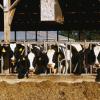
IIASA researchers collaborated with the FAIRR Initiative – a collaborative investor network – on the development of a new IPCC-aligned climate risk analysis tool for investors. Analyses done using the new tool, show that climate-related cost increases could significantly affect the bottom lines of the largest listed livestock companies unless new strategies are urgently adopted.
The FAIRR Initiative today launched an enhanced iteration of its Coller FAIRR Climate Risk Tool providing investors with company-level data on how climate risks may impact costs and profitability in the meat and dairy sector. The tool was produced in collaboration with IIASA and is powered by the Coller FAIRR Climate Risk Model, which is aligned with the most recent scenarios from the IPCC and the Network for Greening the Financial System (NGFS).
The underlying model outputs used to inform the tool comes from the IIASA Global Biosphere Management Model (GLOBIOM) to examine the impacts of forward-looking socioeconomic trends, climate change, and environmental policies to quantify the financial risks and opportunities most material to the biggest livestock companies under three IPCC global warming scenarios, supplemented by data from the latest company disclosures. The tool provides insights into climate risk in 2030 and 2050.
Analyses show that by 2030, in FAIRR’s 2°C ‘Business as Usual’ scenario, the 40 livestock companies analyzed would suffer a 7% reduction in profit margins on average, representing $23.7bn overall. Under this scenario and without mitigations, 20 of these companies, would be operating at a loss. All figures, including cost rises and profit reductions, were calculated compared to 2020 levels.
Potential hits to profits are driven largely by an increase in climate-related costs which are forecast to rise by over 9% on average. Climate change will impact agricultural production, contributing to higher feed prices which account for 5% of the cost rise, with expected carbon taxes on emissions from livestock production making up 4%.
FAIRR’s model has factored in companies’ potential to offset cost increases through the climate mitigation strategies they have publicly disclosed. Yet, only 11 out of the 40 companies disclosed how they plan to mitigate risks from rising feed costs through either data tracking, sourcing diversification, or substituting alternative feed ingredients. Just 6 out of the 40 companies have published a climate scenario analysis, which is widely regarded as a useful tool for planning effective climate risk mitigation strategies. Future profitability will be dependent on companies mitigating these risks or may lead to companies passing costs on. This could mean narrower margins for suppliers, or higher prices for customers and consumers.
At the regional level, North American companies would be the hardest hit – seeing profit margins fall by 11% on average by 2030 among the six companies analyzed in this region, driven by a 15% average cost increase. Rising feed prices will be the biggest contributor as market- and climate-related impacts on feed crops in the region bite, accounting for 14% of the cost rise on average.
“Climate change is a global challenge with regional nuances – the severity of impacts will vary across regions, while at the same time, each region faces its own unique socioeconomic realities that affect their resilience or vulnerability to the changing climate. Using our modeling tools and scenario analysis, we examined how the livestock sector will adapt to climate impacts on feed crops, changing demand for livestock products, as well as the global commitments to reduce greenhouse gas emissions to limit global warming to 1.5 C,” explains Amanda Palazzo, a researcher in the IIASA Biodiversity and Natural Resources Program.
Following the 2°C ‘Business as Usual’ scenario through to 2050, sector profits are forecast to fall by $38bn (10% fall in profit margins on average) as carbon taxes overtake feed price rises as the most significant driver of cost increases. Modeling reveals an average projected cost rise of 14% across the group of 40 companies – including an 8% increase due to carbon taxes, and 5% costs from feed price rises.
Latin America is predicted to be the region worst affected in this scenario, with six companies taking a total profit hit of $14bn, representing a 16% fall in profit margin on average. This is driven by an average 23% cost increase, with predicted carbon taxes driving 16% of the cost rise, and rising feed prices representing 4%.
The Coller FAIRR Climate Risk Tool considers companies’ ability to mitigate climate risks based on their latest disclosures on climate-related factors, as tracked by the annual Coller FAIRR Protein Producer Index.
Some companies are taking action to mitigate risks. One company, for example, has set a Science Based Targets initiative (SBTi) emissions reduction target – a strong deforestation target – and calculated the potential financial impact of carbon prices on their costs. These factors contribute to the potential for the company to mitigate its costs – with FAIRR estimating a 13.6% cost rise in 2030 – instead of 19%, through concrete steps on climate risk management. However, even with those mitigations in place the company still faces a potential $1.9 billion reduction in profits, operating at a negative profit margin of 1.9% by 2030.
“The livestock sector must undergo a radical transformation to reduce emissions intensities and mitigate the well-known environmental and climate impacts of production. The faster and more ambitious we act now, the smoother the transition can be,” concludes IIASA researcher Stefan Frank.
Adapted from a press release prepared by the FAIRR Initiative.
Further information
News

26 July 2024
Navigating new horizons to protect human and planetary health

14 June 2024
IIASA Leadership visits Washington DC

05 June 2024

